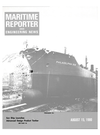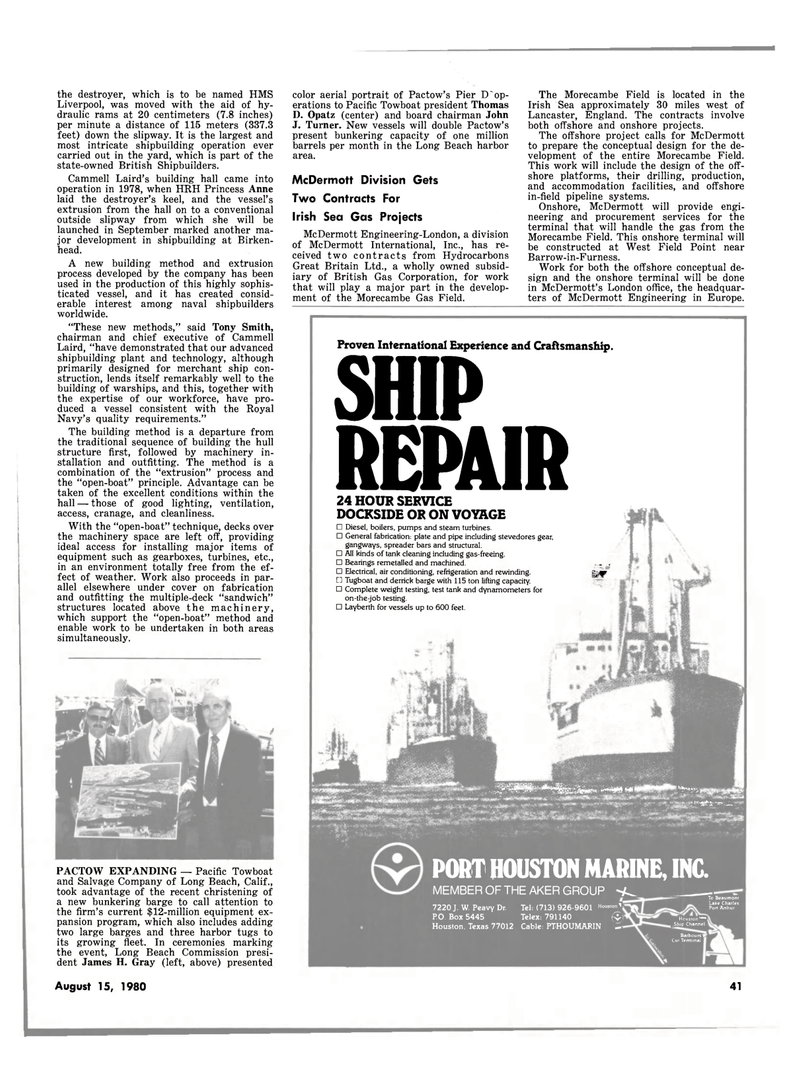
Page 39: of Maritime Reporter Magazine (August 15, 1980)
Read this page in Pdf, Flash or Html5 edition of August 15, 1980 Maritime Reporter Magazine
the destroyer, which is to be named HMS
Liverpool, was moved with the aid of hy- draulic rams at 20 centimeters (7.8 inches) per minute a distance of 115 meters (337.3 feet) down the slipway. It is the largest and most intricate shipbuilding operation ever carried out in the yard, which is part of the state-owned British Shipbuilders.
Cammell Laird's building hall came into operation in 1978, when HRH Princess Anne laid the destroyer's keel, and the vessel's extrusion from the hall on to a conventional outside slipway from which she will be launched in September marked another ma- jor development in shipbuilding at Birken- head.
A new building method and extrusion process developed by the company has been used in the production of this highly sophis- ticated vessel, and it has created consid- erable interest among naval shipbuilders worldwide. "These new methods," said Tony Smith, chairman and chief executive of Cammell
Laird, "have demonstrated that our advanced shipbuilding plant and technology, although primarily designed for merchant ship con- struction, lends itself remarkably well to the building of warships, and this, together with the expertise of our workforce, have pro- duced a vessel consistent with the Royal
Navy's quality requirements."
The building method is a departure from the traditional sequence of building the hull structure first, followed by machinery in- stallation and outfitting. The method is a combination of the "extrusion" process and the "open-boat" principle. Advantage can be taken of the excellent conditions within the hall — those of good lighting, ventilation, access, cranage, and cleanliness.
With the "open-boat" technique, decks over the machinery space are left off, providing ideal access for installing major items of equipment such as gearboxes, turbines, etc., in an environment totally free from the ef- fect of weather. Work also proceeds in par- allel elsewhere under cover on fabrication and outfitting the multiple-deck "sandwich" structures located above the machinery, which support the "open-boat" method and enable work to be undertaken in both areas simultaneously.
PACTOW EXPANDING — Pacific Towboat and Salvage Company of Long Beach, Calif., took advantage of the recent christening of a new bunkering barge to call attention to the firm's current $12-million equipment ex- pansion program, which also includes adding two large barges and three harbor tugs to its growing fleet. In ceremonies marking the event, Long Beach Commission presi- dent James H. Gray (left, above) presented
August 15, 1980 color aerial portrait of Pactow's Pier D" op- erations to Pacific Towboat president Thomas
D. Opatz (center) and board chairman John
J. Turner. New vessels will double Pactow's present bunkering capacity of one million barrels per month in the Long Beach harbor area.
McDermott Division Gets
Two Contracts For
Irish Sea Gas Projects
McDermott Engineering-London, a division of McDermott International, Inc., has re- ceived two contracts from Hydrocarbons
Great Britain Ltd., a wholly owned subsid- iary of British Gas Corporation, for work that will play a major part in the develop- ment of the Morecambe Gas Field.
The Morecambe Field is located in the
Irish Sea approximately 30 miles west of
Lancaster, England. The contracts involve both offshore and onshore projects.
The offshore project calls for McDermott to prepare the conceptual design for the de- velopment of the entire Morecambe Field.
This work will include the design of the off- shore platforms, their drilling, production, and accommodation facilities, and offshore in-field pipeline systems.
Onshore, McDermott will provide engi- neering and procurement services for the terminal that will handle the gas from the
Morecambe Field. This onshore terminal will be constructed at West Field Point near
Barrow-in-Furness.
Work for both the offshore conceptual de- sign and the onshore terminal will be done in McDermott's London office, the headquar- ters of McDermott Engineering in Europe. 41
Houston*-• .Ship Channel
Barbours
Cut Terminal , ^m^m&m i' ^ v-Htti:
PORT HOUSTON MARINE, INC.
MEMBER OF THE AKER GROUP - 7220 J. W. Peavy Dr.
P.O. Box 5445
Houston. Texas 77012
Tel: (713) 926-9601 hoUS,o„^
Telex: 791140 ££
Cable: PTHOUMARIN -
To Beaumont
Lake Charles
Port Arthur
Proven International Experience and Craftsmanship. SHIP
REPAIR 24 HOUR SERVICE
DOCKSIDE OR ON VOYAGE • Diesel, boilers, pumps and steam turbines. • General fabrication: plate and pipe including stevedores gear, gangways, spreader bars and structural. • All kinds of tank cleaning including gas-freeing. • Bearings remetalled and machined. .. • Electrical, air conditioning, refrigeration and rewinding. WW f] Tugboat and derrick barge with 115 ton lifting capacity. • Complete weight testing, test tank and dynamometers for on-the-job testing. • Layberth for vessels up to 600 feet.

 38
38

 40
40
